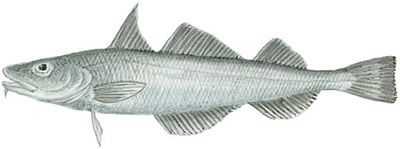Pacific Tomcod

Species Details
Microgadus Proximus
Gadidae
Gadiformes
Deepwater, Coastal
1 - 2 lbs.
9" - 12"
Pacific Tomcod (Microgadus proximus) Fish Description
The pacific tomcod is a species of bony fishes with a torpedo-shaped body covered with small and thin scales. Its topside can range from olive-green to brown, while its underside is white. It has a large head and mouth with a small chin barbel, which makes it distinct from other cod.
The pacific tomcod is commonly identified by its three spineless dorsal fins and two anal fins which are all dusky or grayish, although it may often be confused with the Pacific cod.
The pacific tomcod is a small fish and therefore not commercially important to humans. While it’s considered a popular game fish for anglers in central California, it’s often caught by accident when chasing larger sport fish.
Diet & Size
The pacific tomcod can grow up to 12 inches, but it's commonly reported at 9-10 inches in length. Its diet primarily consists of anchovies, shrimp, worms, amphipods, isopods, gastropods, mussels, and other fish. It has been observed to prey on southern Tanner crab in direct competition with the flathead sole, rock sole, and greenland halibut.
Interesting facts about the Pacific Tomcod
- Fossil records of the pacific tomcod date back to 126,000 years ago
- Its scientific name translates loosely as “Small fish next”
- Considered a “panfish” because it's often caught at sizes that fit in a frying pan
- It’s a favorite prey of seals and sea lions in Canada
- They are sensitive to bright light and can be blinded momentarily
Fishing Techniques: How to Catch a Pacific Tomcod
Pacific tomcod can commonly be caught at piers and harbors north of Monterey Bay in California. Some fishing hot spots would be Pacifica Pier, Pillar Point Harbor Pier, Trinidad Pier, and Point Arena Pier.
In the northern coastal waters, the pacific tomcod can be found in Hand Troller’s Cove (Alaska), Port of Brooking Harbor, and Turtle Creek (Oregon), Parksville Bay (British Columbia), and Rivière Saint-Jacques (Quebec).
The pacific tomcod can be caught on light tackle and are easy enough for children to catch. This fish usually prefers live bait such as strips of anchovy or squid and pile worms. Some anglers report that jigging spoons are effective as well.
A size 6 or 8 circle hook is best, and you can use a sinker or slip float as well if fishing for the pacific tomcod. A common technique used is casting out, letting the bait hook hit the bottom, and retrieving it quickly. This fish will usually bite during the upward retrieval at mid-depth. The pacific tomcod is a fast schooling fish, so be alert when they bite.
Habitat & Distribution
The pacific tomcod is commonly found in the coastal waters of North America from the southeastern Bering Sea to Point Sal in central California. They have also been documented as far north in eastern Pacific waters in Alaska and Canada and sometimes in the Arctic Ocean. It’s a demersal fish that prefers marine and brackish waters with soft bottoms composed of mud, silt, or fine sand.
They are usually at depths of 90-720 feet deep but can go as deep as 885 feet. Juveniles prefer shallow depths in summer and fall, while adults dwell at deeper depths. They are gregarious and may share the same habitat with the white croaker and barred surfperch.
Spawning usually occurs from January to April, and females will release their eggs into open water to be fertilized. This fish does not guard eggs or their young. Schools of juveniles around 4-8 inches long have been spotted at night around Smitty’s Cove in Whittier, Alaska, and can be mixed in with walleye pollock.





